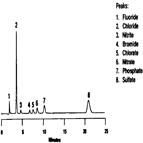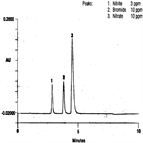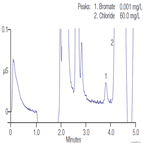Find methods for your needs
Refine by Feature
Displaying 1-3 of 3 results for Tag: IonPac AS9-SC
AN51: Method for Determination of Anions in Sodium Hydroxide
Instrument Type: ICCaustic manufacturers need an accurate method to monitor the concentration of chlorate and other anions in their chlor-alkali processes. In chlor-alkali processes, chlorine and sodium hydroxide are produced by the electrolysis of a saturated brine solution. Monitoring the chlorate concentration ensures the process is working correctly. This method is used to determine the levels of anionic impurities in a 50% sodium hydroxide solution. Anions which can be determined by this method include chloride, nitrite, sulfate, phosphate, chlorate, and nitrate.
AU132: Determination of Nitrite and Nitrate in Drinking Water Using Ion Chromatography with Direct UV Detection
Instrument Type: ICThe ion chromatographic analysis of nitrite and nitrate in drinking water can be accomplished using direct UV detection of the analytes. The method of chemically suppressed conductivity detection of nitrite and nitrate in drinking water (Application Update #131) is an alternative to this method. This Application Update combines chemical suppression and UV detection to reduce background absorbance and eliminate the negative peaks associated with chloride and sulfate to facilitate the determination of nitrite and nitrate.
AN101: Trace Level Determination of Bromate in Ozonated Drinking Water Using Ion Chromatography.
Instrument Type: ICThis application note reports the development of a modified IC method that significantly improves the method detection limits for bromate by sample preconcentration. This method is consistent with the proposed American Society for Testing and Materials (ASTM) method for bromate. A weak borate eluent is used to elute the concentrated anions through the analytical column where they are separated & through the suppressed conductivity detector, they are quantified. Today we would use an approach that does not require sample preparation such as that in AN167.



